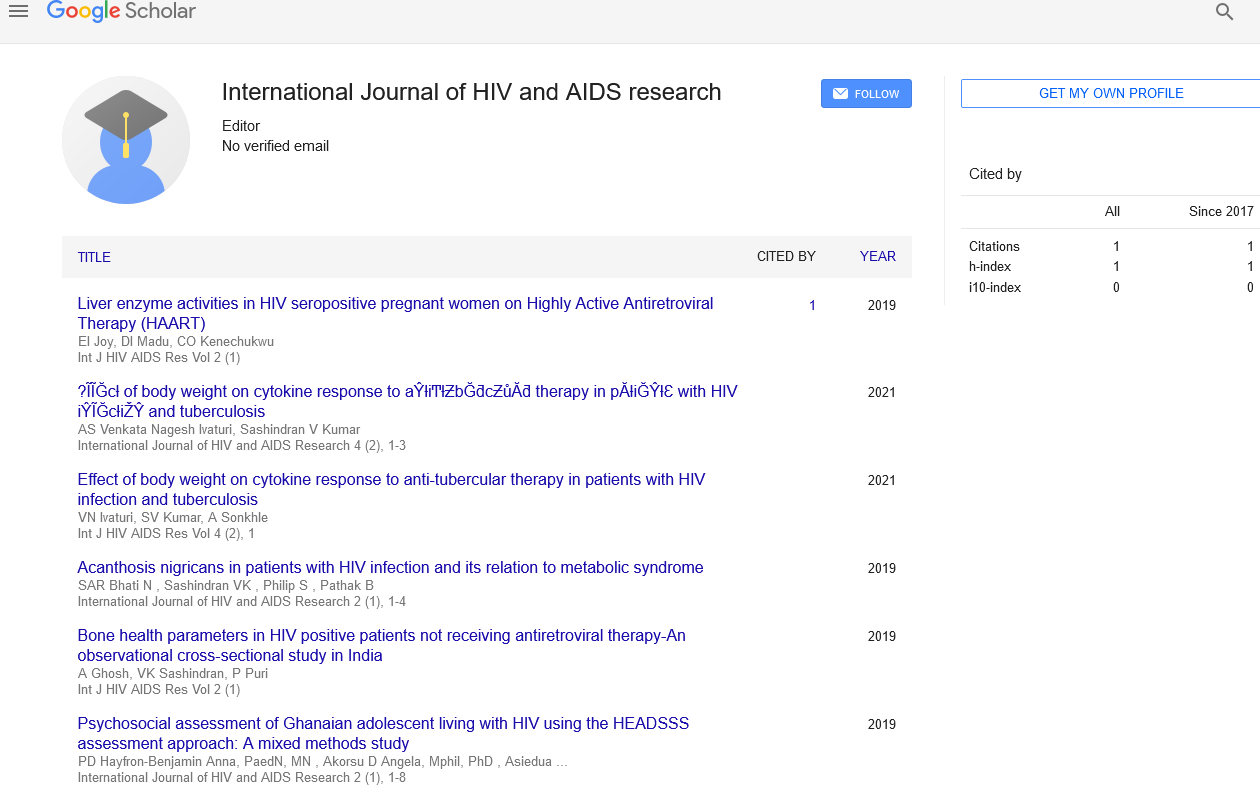HIV and alcohol use: Addressing the issues
Received: 01-Mar-2022, Manuscript No. PULIJHAR-22-4669; Editor assigned: 03-Mar-2022, Pre QC No. PULIJHAR-22-4669 (PQ); Accepted Date: Mar 15, 2022; Reviewed: 09-Mar-2022 QC No. PULIJHAR-22-4669(Q); Revised: 12-Mar-2022, Manuscript No. PULIJHAR-22-4669 (R); Published: 29-Mar-2022, DOI: DOI:10.37532/pulijhar.22.5(2).11
Citation: Harrison R. HIV and alcohol use: Addressing the issues. J HIV AIDS Res. 2022;5(2): 11.
This open-access article is distributed under the terms of the Creative Commons Attribution Non-Commercial License (CC BY-NC) (http://creativecommons.org/licenses/by-nc/4.0/), which permits reuse, distribution and reproduction of the article, provided that the original work is properly cited and the reuse is restricted to noncommercial purposes. For commercial reuse, contact reprints@pulsus.com
Abstract
Liquor use and torment are regular issues among individuals living with HIV/AIDS (PLWHA). Subsequently, expanding the comprehension of the collaboration between these ailments is basic to further develop medical care and personal satisfaction for this populace. While distinctions in sexual orientation in liquor use and state of mind problems are broadly perceived, little is had some significant awareness of orientation incongruities in solution of pain relievers and connects. Similarly significant is the absence of data in regards to the job of neurotrophic factors albeit creature models have shown BDNF pronociceptive impacts.
Key Words
Dideoxynucleoside; HIV; Antiretrovirals; Neuropsychological issues
Introduction
Persistent agony, characterized as progressing torment enduring longer than a half year, is a critical issue among Individuals Living With HIV (PLWHA). Without a doubt, information recommends that as numerous 66% of PLWHA announced experiencing constant agony. Among PLWHA, torment might emerge because of the immediate impacts of the infection on the focal or fringe sensory system. Outstandingly, a sizable extent of agony studies have been acted in the start of the pestilence, and torment was for the most part connected with cutting edge phases of Human Immunodeficiency Virus/Acquired Immune Deficiency Syndrome (HIV/ AIDS). Be that as it may, presently a-days the contrary side of the range is likewise noticed. With the far reaching utilization of antiretrovirals, torment can arise as the consequence of the harmful impacts of specific treatment regimens. Dideoxynucleoside analogs hinder neurite outgrowth. Nucleoside turns around transcriptase inhibitors additionally instigate mitochondrial poisonousness, setting off torment. Albeit less successive, protease inhibitors have additionally been related with torment. Beyond direct tissue harm, persistent agony could be the aftereffect of focal sharpening, in which the cerebrum gets a solid sign of torment inspired by low or harmless sensations. Focal refinement has been related with conditions, for example, enslavement and neuropsychological issues. Focal sharpening is especially significant in this bunch on the grounds that a huge extent of PLWHA misuse liquor. Sadly, research in this space is as yet restricted and exceptionally discussed, as it is hazy if: a) torment turns into an issue since torment edges are brought down in liquor clients when they are level-headed, or b) assuming that these people are utilizing expanded measures of liquor searching for ethanol’s likely pain relieving impacts or c) on the off chance that agony is connected with the subject’s hopes or mood. Furthermore, torment research is generally restricted to creature models or to investigations of instigated torment in lab settings where the passionate parts and ecological stressors are absent. This is a huge downside, as earlier examination has shown that mind-set and mental misery are huge indicators of torment and pain reliever use/misuse. In like manner, our multi-layered model incorporates organic, mental and social factors. Our proposed model goes one stage forward by recommending that Brain-Derived Neurotrophic Factor (BDNF) lopsidedness is a significant organic instrument interceding the expanded paces of agony/pain reliever use in PLWHA, especially those utilizing liquor. This proposition depends on earlier preclinical information demonstrating that aggravation refinement is a type of maladaptive brain adaptability, which is generally constrained by BDNF. Studies to decide the connection between agony, liquor and BDNF among PLWHA are missing, yet significant initial steps to further develop information and clinical administration of torment. Subsequently, this is the fundamental objective of this article. In the event that our proposes are right, BDNF might address another objective for drug improvement for this at need populace.
Conclusion
The administration of persistent agony is a mind boggling one, since people experiencing constant torment every now and again have other attending clinical and mental circumstances, including disposition issues. While utilization of pain relievers might be less affected by discouragement for men than for ladies, apparently mental misery is exceptionally powerful in both. It is very much archived those ladies in everybody and PLWHA proof higher paces of state of mind problems (for example sadness, uneasiness). Simultaneous circumstances among ladies should be surveyed and tended to in medicines, as they might be etiologically related. Discoveries are in accordance with our earlier investigations demonstrating that trouble is a significant trigger for BDNF changes, as well concerning liquor use. Independent of orientation, clinical intercessions, and pharmacologic medicines pointed toward focusing on and moderating mental pain might fill in as a significant precaution work. Independent of orientation, intercessions tending to mental trouble might moderate a portion of these pertinent clinical issues. Beyond these significant segment variables, race and orientation stay as key elements in examples of liquor use ways of behaving, yet they remain understudied parts of endlessly pain reliever use. Like our discoveries, studies among everybody show that Caucasians will quite often utilize pain relievers at higher rates than minority bunches However, among females we have found that Hispanics and African American ladies are bound to utilize pain relievers. This example merits further examination.





